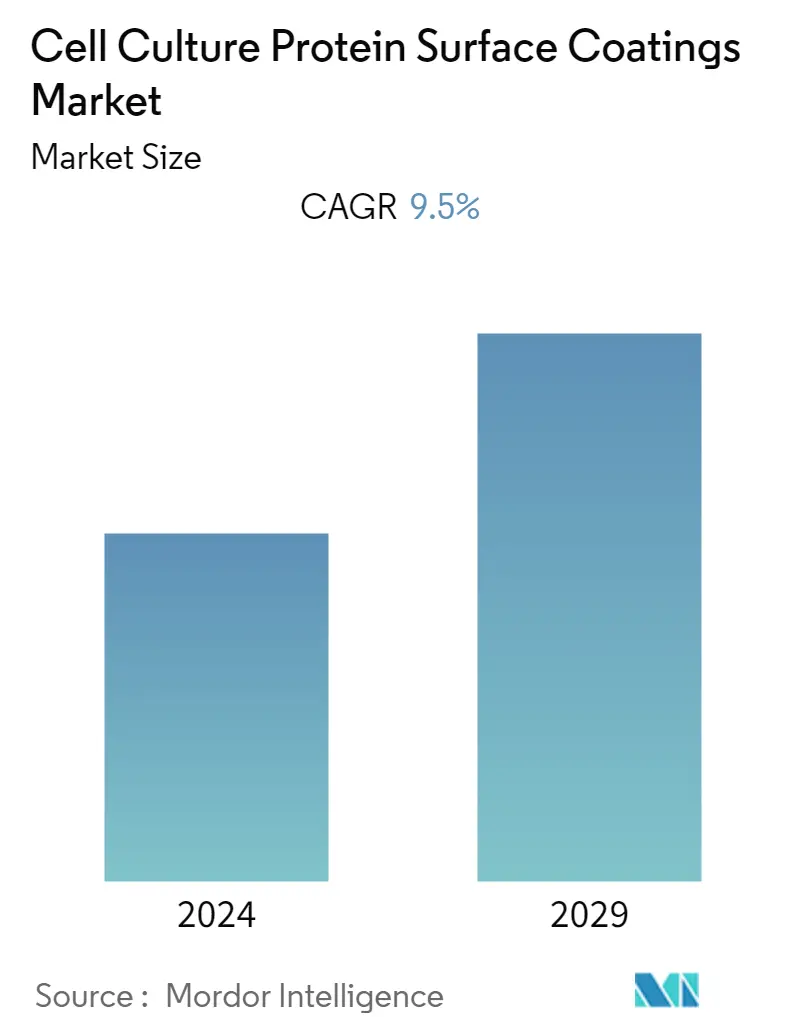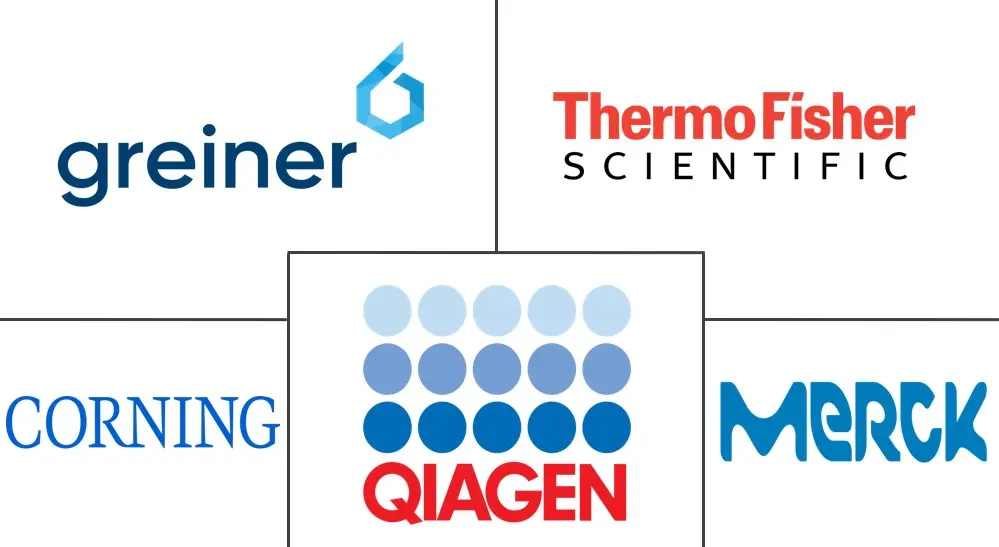Market Size of Cell Culture Protein Surface Coatings Industry

| Study Period | 2019 - 2029 |
| Base Year For Estimation | 2023 |
| Forecast Data Period | 2024 - 2029 |
| CAGR | 9.50 % |
| Fastest Growing Market | Asia-Pacific |
| Largest Market | North America |
Major Players
*Disclaimer: Major Players sorted in no particular order |
Cell Culture Protein Surface Coatings Market Analysis
The cell culture protein surface coatings market is expected to register a CAGR of 9.5% over the forecast period. When COVID-19 first appeared, a lot of biotech and pharmaceutical companies, governments from different nations, and research institutions began to concentrate on the creation of efficient vaccines and novel treatments to treat the problem. The creation of new vaccines for the treatment of COVID-19 was facilitated by cell culture.
- As per the report published by the Journal of Clinical Virology in July 2022, there was a significant positive correlation between the probability of isolating SARS-CoV-2 in culture, fewer days of symptoms, and a lower RT-PCR cycle threshold value. Hence the cell culture was used during COVID-19 for proper diagnosis and was expected to grow the cell culture protein surface coatings market. As viral studies are still ongoing, it is expected to have a significant impact in the coming future.
- The major factors, such as increasing stem cell research activities, increasing demand for protein therapeutics and targeted therapy, and growing preference for 3D cell cultures over 2D cell cultures, are driving the growth of the market over the forecast period.
- The optimization of the cell culture environment enables cells to grow, function, and survive in a realistic and representative manner. The surface coating of cell culture with protein involves coating the cell culture surface with extracellular matrix or protein components to improve the proliferation and adhesion of the cells in-vitro. Increasing stem cell research activities are expected to have a positive impact on the growth of the market.
- For instance, in June 2022, the Harvard Stem Cell Institute (HSCI) invited applications for seed grant funding for its 2022 cycle. The program's objective is to offer financial support for creative initiatives in the field of stem cell and regenerative biology to accelerate the development of new stem cell-based therapies or cures. As per the same above-mentioned source, the amounted award is USD 100,000 per project per year for up to two years. Thus the funding for the research activities increases the stem cell research activities that may drive the growth of the market over the forecast period.
- However, the high cost of cell culture protein surface coatings products and restrictions against the use of animal-source protein coating material may impede the growth of the market.
Cell Culture Protein Surface Coatings Industry Segmentation
As per the scope of the report, coating as an additional surface treatment stands for all additional modifications made to increase cell adhesion. The cell culture protein surface coatings market is expected to register a CAGR of 9.5% over the forecast period. The cell culture protein surface coatings market is segmented by protein source (animal-derived protein, human-derived protein, synthetic protein, and plant-derived protein), type of coating (self-coating and pre-coatings), and geography (North America, Europe, Asia-Pacific, Middle East, and Africa, and South America). The report also covers the estimated market sizes and trends for 17 countries across major regions globally. The report offers the value (in USD million) for the above segments.
| By Protein Source | |
| Animal-derived Protein | |
| Human-derived Protein | |
| Synthetic Protein | |
| Plant-derived Protein |
| By Type of Coating | |||||||
| Self-coating | |||||||
|
| Geography | ||||||||
| ||||||||
| ||||||||
| ||||||||
| ||||||||
|
Cell Culture Protein Surface Coatings Market Size Summary
The cell culture protein surface coatings market is poised for significant growth, driven by increasing activities in stem cell research, the rising demand for protein therapeutics and targeted therapies, and a growing preference for 3D over 2D cell cultures. The optimization of cell culture environments through protein surface coatings enhances cell proliferation and adhesion, which is crucial for in-vitro studies. The market's expansion is further supported by advancements in microwell plates and microplate readers, which are becoming standard tools in analytical research and clinical diagnostics. These technological innovations are expected to bolster the market's growth trajectory over the forecast period.
North America is anticipated to lead the market, supported by substantial funding for healthcare research and a strong presence of cell culture laboratories. The region's dominance is reinforced by significant investments from organizations like the National Institutes of Health and the National Cancer Institute, which fund research in cancer and personalized medicine. The increasing incidence of cancer cases is driving the demand for targeted therapies, which rely on cell culture techniques. Additionally, the market is characterized by moderate fragmentation, with key players focusing on technological advancements in protein technology and cell culture methods. These factors collectively contribute to the market's robust growth prospects in the coming years.
Cell Culture Protein Surface Coatings Market Size - Table of Contents
-
1. MARKET DYNAMICS
-
1.1 Market Overview
-
1.2 Market Drivers
-
1.2.1 Increasing Stem Cell Research Activities
-
1.2.2 Increasing Demand of Protein Therapeutics and Targeted Therapy
-
1.2.3 Growing Preference for 3D Cell Cultures over 2D Cell Cultures
-
-
1.3 Market Restraints
-
1.3.1 High Cost of Cell Culture Protein Surface Coatings Products
-
1.3.2 Restriction Against Use of Animal Source Protein Coating Material
-
-
1.4 Porter's Five Forces Analysis
-
1.4.1 Threat of New Entrants
-
1.4.2 Bargaining Power of Buyers/Consumers
-
1.4.3 Bargaining Power of Suppliers
-
1.4.4 Threat of Substitute Products
-
1.4.5 Intensity of Competitive Rivalry
-
-
-
2. MARKET SEGMENTATION (Market Size by Value - USD million)
-
2.1 By Protein Source
-
2.1.1 Animal-derived Protein
-
2.1.2 Human-derived Protein
-
2.1.3 Synthetic Protein
-
2.1.4 Plant-derived Protein
-
-
2.2 By Type of Coating
-
2.2.1 Self-coating
-
2.2.2 Pre-coating
-
2.2.2.1 Microwell Plates
-
2.2.2.2 Petri Dish
-
2.2.2.3 Flask
-
2.2.2.4 Slides
-
2.2.2.5 Other Types of Pre-coatings
-
-
-
2.3 Geography
-
2.3.1 North America
-
2.3.1.1 United States
-
2.3.1.2 Canada
-
2.3.1.3 Mexico
-
-
2.3.2 Europe
-
2.3.2.1 France
-
2.3.2.2 Germany
-
2.3.2.3 United Kingsom
-
2.3.2.4 Italy
-
2.3.2.5 Spain
-
2.3.2.6 Rest of Europe
-
-
2.3.3 Asia-Pacific
-
2.3.3.1 China
-
2.3.3.2 Japan
-
2.3.3.3 India
-
2.3.3.4 Australia
-
2.3.3.5 South Korea
-
2.3.3.6 Rest of Asia-Pacific
-
-
2.3.4 Middle East and Africa
-
2.3.4.1 GCC
-
2.3.4.2 South Africa
-
2.3.4.3 Rest of Middle East and Africa
-
-
2.3.5 South America
-
2.3.5.1 Brazil
-
2.3.5.2 Argentina
-
2.3.5.3 Rest of South America
-
-
-
Cell Culture Protein Surface Coatings Market Size FAQs
What is the current Cell Culture Protein Surface Coatings Market size?
The Cell Culture Protein Surface Coatings Market is projected to register a CAGR of 9.5% during the forecast period (2024-2029)
Who are the key players in Cell Culture Protein Surface Coatings Market?
Corning Incorporated, Qiagen NV, Thermo Fisher Scientific Inc., Greiner AG (Greiner Bio-One International GmbH) and Merck KGaA are the major companies operating in the Cell Culture Protein Surface Coatings Market.

